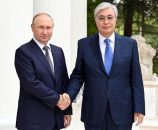Afia Ambreen
President of the Russian Federation Vladimir V Putin paid an official visit to New Delhi from October 4-5 for the 19t India-Russia annual bilateral summit. Traditionally, Russia has maintained cordial relations with India, with an overwhelming focus on the defense sector. Both nations signed the Treaty of Peace, Friendship and Cooperation In 1971, which specified mutual strategic cooperation. For a long period of time, Russia enjoyed the status of the largest arms exporter to India. After the establishment of U.S.-India strategic relations, however, Russia gradually started to lose lucrative defense deals to U.S. firms. Consequently, in 2014, the United States surpassed Russia and became India’s biggest defense partner in terms of arms sales.
Today, the relationship has become one-dimensional, centered on arms sales by Russia to India. Between 2000 and 2014, 73% of India’s imported military equipment came from Russia. But India’s imports from Russia halved overnight following its annexation of Crimea in 2014, and have remained lower at about 50-60% amid international sanctions. Meanwhile, overall India-Russia trade has been slight, rising from $6 billion in 2014 to $10.7 billion this year. Although energy relations are deepening, the overall economic relationship remains narrow, not helped by the poor performance of the Russian economy. Just five years ago, Russia’s GDP was 20% larger than India’s; today, India’s is 70% larger than Russia’s.
The summit meeting between Indian Prime Minister Narendra Modi and Russian President Vladimir Putin was an effort by New Delhi to allay Moscow’s growing apprehension that its long-standing strategic partner and largest arms buyer has been lost forever to the United States. In concluding a US$5.43 billion deal for five regiments of Russia’s S-400 Triumf long-range air defence system, New Delhi signalled that, notwithstanding the growing US-India strategic and military partnership, India’s strategic balance and its dependence on Russian submarine and missile technologies requires it to continue buying arms from Moscow.
It is pertinent to mention that US urged India to forgo its proposed deal to buy the S-400 missile defence system from Russia, warning that the deal could attract American sanctions. However, to lessen the impact in Washington, the announcement of the S-400 purchase was done in a conspicuously low-key manner. Both Modi and Putin avoided any mention of the deal in their press engagements. Nor did the S-400 contract feature in an official list of agreements signed. Instead, this significant acquisition was announced through a single brief sentence buried in the 45th paragraph of an official joint statement: “The sides [New Delhi and Moscow] welcomed the conclusion of the contract for the supply of the S-400 long-range surface-to-air missile system to India.” Even so, the S-400 buy renders India vulnerable to US sanctions under legislation passed in mid-2007. The “Countering America’s Adversaries Through Sanctions Act” (CAATSA) binds Washington to sanction countries that enter into “significant transactions” with specified Russian, Iranian and North Korean defence and intelligence entities, including Almaz-Antey Corporation, which manufactures the S-400. The US president can waive CAATSA sanctions at his discretion but, President Donald Trump appeared to taunt New Delhi, telling reporters that “India is going to find out … sooner than you think” whether sanctions were coming.
CAATSA, if implemented in its stringent form, is likely to affect India’s arms procurement from Russia in a number of ways. First, India’s planned procurement from Russia, particularly the S-400 air defence system, Project 1135.6 frigates and Ka226T helicopters, will come under the immediate scanner of US authorities, as they are mandated to deter exports of key Russian defence entities. In all likelihood, US authorities will try to influence their Indian counterparts to ignore the Russian platforms, though it is entirely up to New Delhi to make its own judgment. Second, CAATSA is likely to affect all the joint ventures (JVs) – existing or planned — between Indian and Russian defence companies. Some of the existing JVs that may come under the scanner are: Indo Russian Aviation Ltd, Multi-Role Transport Aircraft Ltd and Brahmos Aerospace. Third, the Act will also affect India’s purchase of spare parts, components, raw materials and other assistance for which Indian entities are dependent on Russia for domestic licence manufacturing and maintenance of existing equipment.
Ironically, India spends huge amount of its budget on defence despite being nuclear power and continues to threaten other states by such artifices. Based on quest of India for arms race, India must see that because of these moves other states are compelled for same actions. It is spending huge amount of its defence budget without thinking what kind of bloodshed it is doing in Kashmir and how it is enforcing other states in South Asia for arms race. Pakistan surely has all the potentials to maintain balance and develop arms but as a peace loving country it has no such desire of more arms rather it believes in maintaining status-quo with its nuclear armed neighbour and long awaited disputes to be resolved peacefully.



